Simulation of the First Two Microseconds of an Ar CCP Cold Plasma Discharge by the PIC-MCC Method
Abstract
:1. Introduction
2. Materials and Methods
2.1. Physical Characteristics of the Simulated Discharge
2.2. Details of the Simulation Process
- the RF period was divided in 7375 time steps, providing good resolution of the RF behavior;
- the probability of obtaining a collision during a time step (given by Equation (A1)) was lower than 0.05, providing a negligible probability of multiple collisions during a time step;
- considering that the plasma frequency was always νP < 2 × 109 s−1 during all simulation runs (see Section 3.5), the condition νP ∆t < 0.1 was always satisfied;
- considering that the minimum value of the Debye length was about 200 μm (see Section 3.3), the condition ∆z < λD was always satisfied;
- the particles were not able to travel a distance greater than ∆z during a time step; the speed required to do so is v = ∆z/∆t = 6.67 × 106 m s−1, which for an electron requires a kinetic energy of about 126 keV, much higher than the electron energy in the EEDF tails (see Section 3.7).
2.3. Calculated Plasma Parameters
3. Results
3.1. Electron Density
3.2. Electron Mean Energy
3.3. Debye Length
3.4. Debye Number
3.5. Plasma Frequency
3.6. Spatial Distribution of the Electric Potential
3.7. Electron Energy Distribution Functions
3.8. Variability of the Simulation Results
4. Discussion
5. Conclusions
Funding
Data Availability Statement
Conflicts of Interest
Appendix A. Description of the CCPLA Software
- geometrical characteristics of the discharge: electrodes lateral size and distance between them;
- characteristics of the sinusoidal electric signal applied to the electrodes: peak voltage amplitude, frequency and initial phase;
- simulation time step, time between data acquisition, and requested simulated time;
- tabulated cross section values for the collision processes considered in the simulation.
- electric current flowing between the electrodes;
- electric potential distribution along the axis normal to the electrodes;
- electron number density;
- electron energy: mean, maximum, minimum values, and standard deviation;
- angle between electron velocity vector and electric field direction: mean, maximum, minimum values, and standard deviation;
- electron energy distribution function;
- ion energy distribution function.
- dissociation rate;
- dissociation rate constant.
Appendix A.1. Simulation Modules
- PIC module: calculation of the electric potential, electric field, and particle acceleration components, using the particle-in-cell scheme in one dimension (normal to the electrodes surfaces);
- particle mover: calculates the new velocity components and positions of electrons and ions at each time step, using the leap-frog scheme, on the basis of the acceleration computed by the PIC module;
- collision manager: checks which particles experienced a collision, using a montecarlo method, and manages the collision effects, such as changing particles velocities and creating a list of particles to add or remove;
- particle manager: adds the electrons and ions produced by the ionization events, removes the particles that reached the electrodes and manages the variable weights.
Appendix A.2. PIC Module
Appendix A.3. Particle Mover
Appendix A.4. Collision Manager
Appendix A.5. Particle Manager
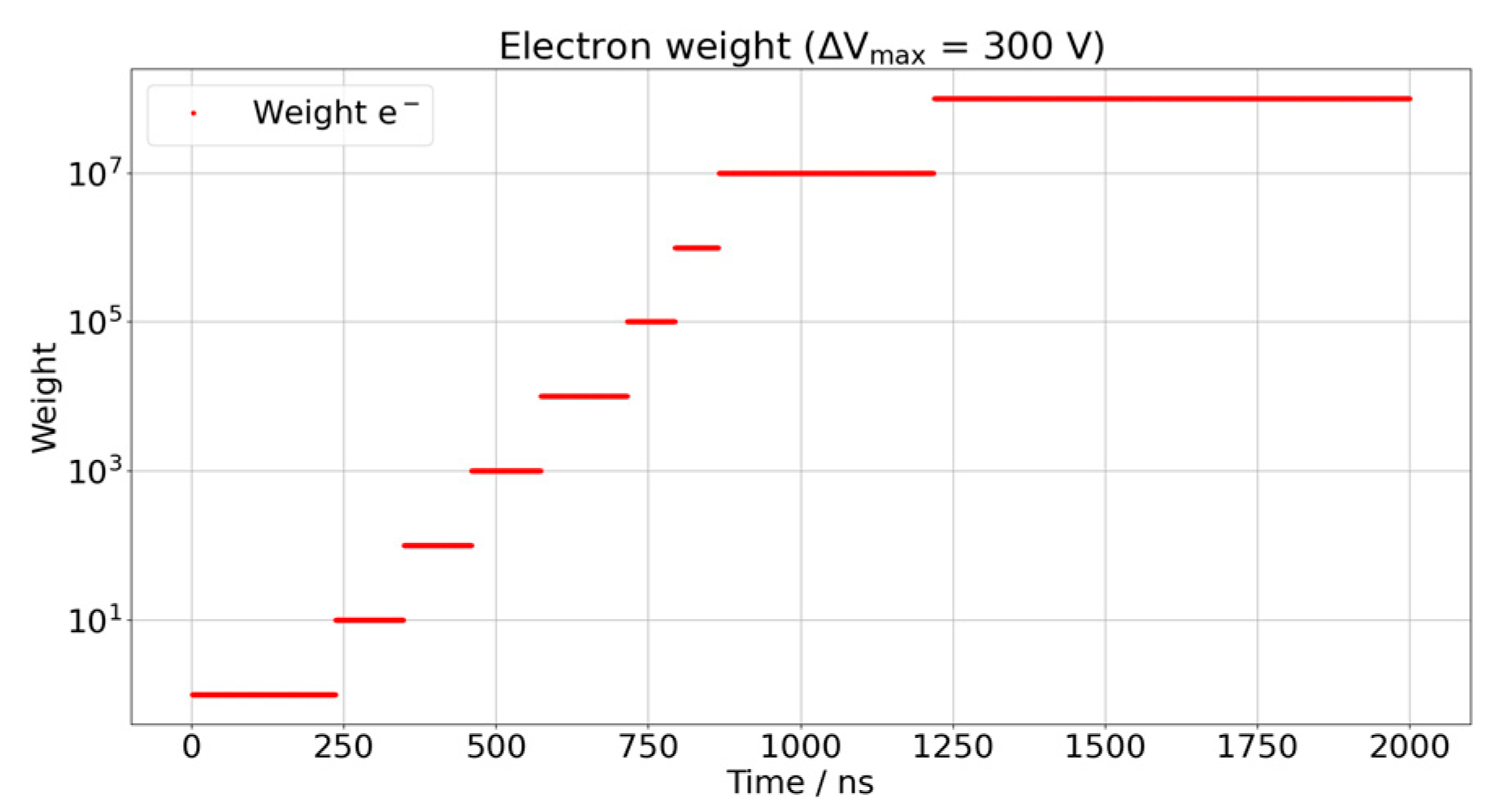
Appendix B. Methods Used to Calculate the Plasma Parameters
References
- Chabert, P.; Tsankov, T.V.; Czarnetzki, U. Foundations of capacitive and inductive radio-frequency discharges. Plasma Sources Sci. Technol. 2021, 30, 024001. [Google Scholar] [CrossRef]
- Ostrikov, K.; Xu, S.; Huang, S.Y.; Levchenko, I. Nanoscale surface and interface engineering: Why plasma-aided? Surf. Coat. Tech. 2008, 202, 5314–5318. [Google Scholar] [CrossRef]
- Marchack, N.; Buzi, L.; Farmer, D.B.; Miyazoe, H.; Papalia, J.M.; Yan, H.; Totir, G.; Engelmann, S.U. Plasma processing for advanced microelectronics beyond CMOS. J. Appl. Phys. 2021, 130, 080901. [Google Scholar] [CrossRef]
- Xiao, S.Q.; Xu, S.; Ostrikov, K. Low-temperature plasma processing for Si photovoltaics. Mat. Sci. Eng. R 2014, 78, 1–29. [Google Scholar] [CrossRef]
- Granqvist, C.G. Electrochromics for smart windows: Oxide-based thin films and devices. Thin Solid Film. 2014, 564, 1–38. [Google Scholar] [CrossRef]
- Hammer, T. Atmospheric Pressure Plasma Application for Pollution Control in Industrial Processes. Contrib. Plasma Phys. 2014, 54, 187–201. [Google Scholar] [CrossRef]
- Vasudev, M.C.; Anderson, K.D.; Bunning, T.J.; Tsukruk, V.V.; Naik, R.R. Exploration of Plasma-Enhanced Chemical Vapor Deposition as a Method for Thin-Film Fabrication with Biological Applications. ACS Appl. Mater. Interfaces 2013, 5, 3983–3994. [Google Scholar] [CrossRef]
- Weltmann, K.D.; von Woedtke, T. Plasma medicine-current state of research. Plasma Phys. Control. Fusion 2017, 59, 014031. [Google Scholar] [CrossRef]
- Cha, S.; Park, Y.-S. Plasma in dentistry. Clin. Plasma Med. 2014, 2, 4–10. [Google Scholar] [CrossRef]
- Wang, X.-Y.; Liu, J.-R.; Liu, Y.-X.; Donko, Z.; Zhang, Q.-Z.; Zhao, K.; Schulze, J.; Wang, Y.N. Comprehensive understanding of the ignition process of a pulsed capacitively coupled radio frequency discharge: The effect of power-off duration. Plasma Sources Sci. Technol. 2021, 30, 075011. [Google Scholar] [CrossRef]
- Ma, F.-F.; Zhang, Q.-Z.; Schulze, J.; Sun, J.-Y.; Wang, Y.-N. Temporal evolution of plasma characteristics in synchronized dual-level RF pulsed capacitively coupled discharge. Plasma Sources Sci. Technol. 2021, 30, 105018. [Google Scholar] [CrossRef]
- Su, Z.-X.; Shi, D.-H.; Liu, Y.-X.; Zhao, K.; Gao, F.; Wang, Y.-N. Radially-dependent ignition process of a pulsed capacitively coupled RF argon plasma over 300 mm-diameter electrodes: Multi-fold experimental diagnostics. Plasma Sources Sci. Technol. 2021, 30, 125013. [Google Scholar] [CrossRef]
- Darnon, M.; Cunge, G.; Braithwaite, N.J. Time-resolved ion flux, electron temperature and plasma density measurements in a pulsed Ar plasma using a capacitively coupled planar probe. Plasma Sources Sci. Technol. 2014, 23, 025002. [Google Scholar] [CrossRef]
- Denysenko, I.B.; von Wahl, E.; Mikikian, M.; Berndt, J.; Ivko, S.; Kersten, H.; Kovacevic, E.; Azarenkov, D.M.; Cunge, G.; Braithwaite, N.J. Plasma properties as function of time in Ar/C2H2 dust-forming plasma. J. Phys. D Appl. Phys. 2020, 53, 135203. [Google Scholar] [CrossRef]
- Schulze, J.; Derzsi, A.; Dittmann, K.; Hemke, T.; Meichsner, J.; Donko, Z. Ionization by Drift and Ambipolar Electric Fields in Electronegative Capacitive Radio Frequency Plasmas. Phys. Rev. Lett. 2011, 107, 275001. [Google Scholar] [CrossRef]
- Schmidt, N.; Schulze, J.; Schungel, E.; Czarnetzki, U. Effect of structured electrodes on heating and plasma uniformity in capacitive discharges. J. Phys. D Appl. Phys. 2013, 46, 505202. [Google Scholar] [CrossRef]
- Behounek, F.; Kletschka, J.A. Ionization of Air in an Air-conditioned Building. Nature 1938, 142, 956. [Google Scholar] [CrossRef]
- Suchanowski, A.; Wiszniewski, A. Changes in Ion Concentration in the Air during the Breathing Process of a Human Being. Pol. J. Environ. Stud. 1999, 8, 259–263. [Google Scholar]
- Donkó, Z.; Derzsi, A.; Máté Vass, M.; Horváth, B.; Wilczek, S.; Hartmann, B.; Hartmann, P. eduPIC: An introductory particle based code for radio-frequency plasma simulation. Plasma Sources Sci. Technol. 2021, 30, 095017. [Google Scholar] [CrossRef]
- Raju, G.G. Electron-atom Collision Cross Sections in Argon: An Analysis and Comments. IEEE Trans. Dielectr. Electr. Insul. 2004, 11, 649–673. [Google Scholar] [CrossRef]
- Bogaerts, A.; Van Straaten, M.; Gijbel, R. Monte Carlo simulation of an analytical glow discharge: Motion of electrons, ions and fast neutrals in the cathode dark space. Spectrochim. Acta 1995, 50B, 179–196. [Google Scholar] [CrossRef]
- Schumacher, U. Basics of Plasma Physics. In Lecture Notes in Physics-Plasma Physics; Dinklage, A., Klinger, T., Marx, G., Schweikhard, L., Eds.; Springer: Berlin/Heidelberg, Germany, 2005; pp. 3–20. [Google Scholar]
- Von Keudell, A.; Schulz-von der Gathen, V. Foundations of low-temperature plasma physics-an introduction. Plasma Sources Sci. Technol. 2017, 26, 113001. [Google Scholar] [CrossRef]
- Pysica 0.2.0. Available online: https://pypi.org/project/pysica (accessed on 15 August 2022).
- GNU General Public License. Available online: https://www.gnu.org/licenses/gpl-3.0.html (accessed on 14 August 2022).
- Peterson, P. F2PY: A tool for connecting Fortran and Python programs. Int. J. Comput. Sci. Eng. 2009, 4, 296–305. [Google Scholar] [CrossRef]
- The GNU Fortran Compiler. Available online: https://gcc.gnu.org/onlinedocs/gfortran (accessed on 14 August 2022).
- Birdsall, C.K. Particle-in-Cell Charged-Particle Simulations, Plus Monte Carlo Collisions With Neutral Atoms, PC-MCC. IEEE Trans. Sci. 1991, 19, 65–85. [Google Scholar]
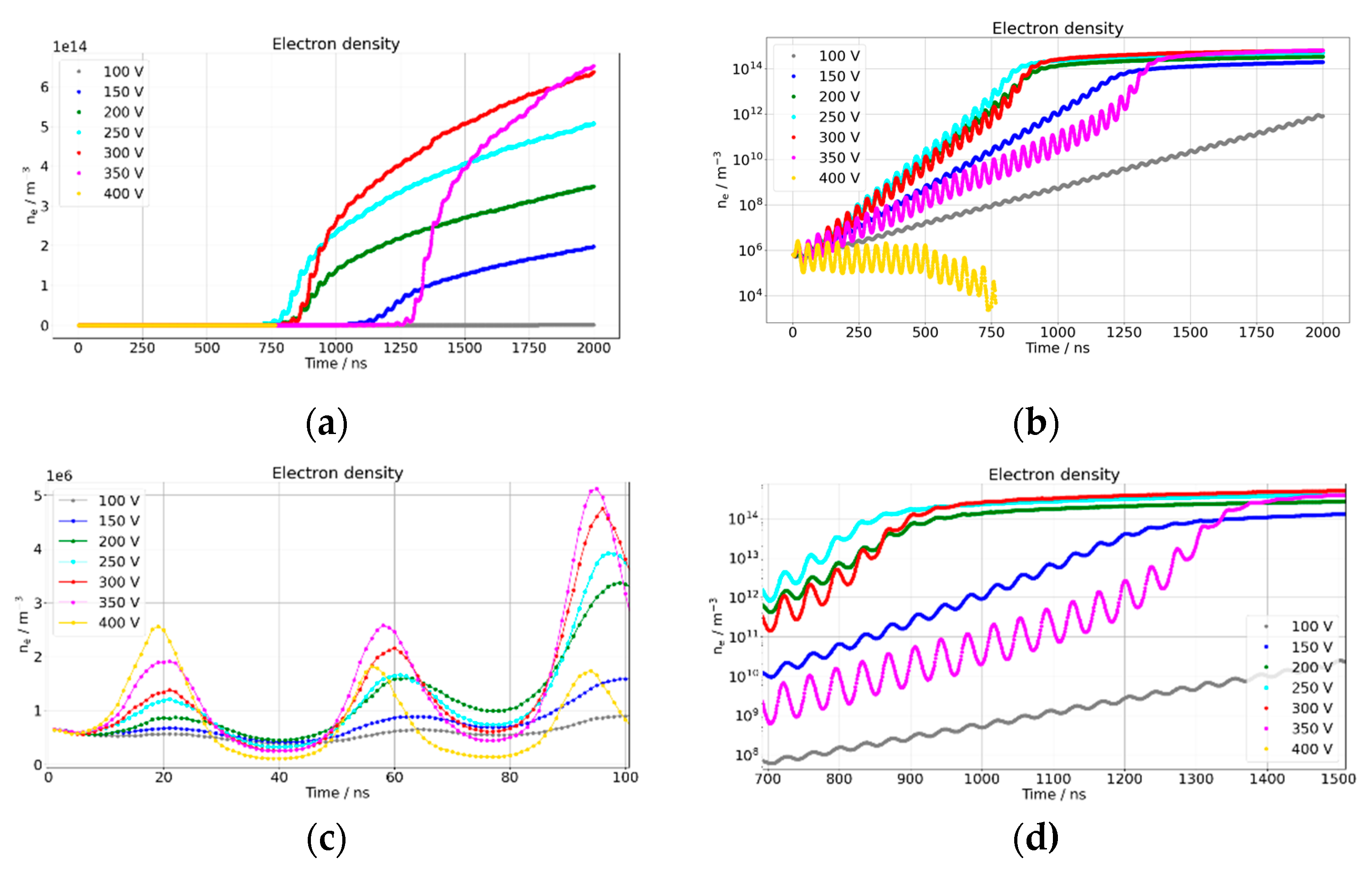
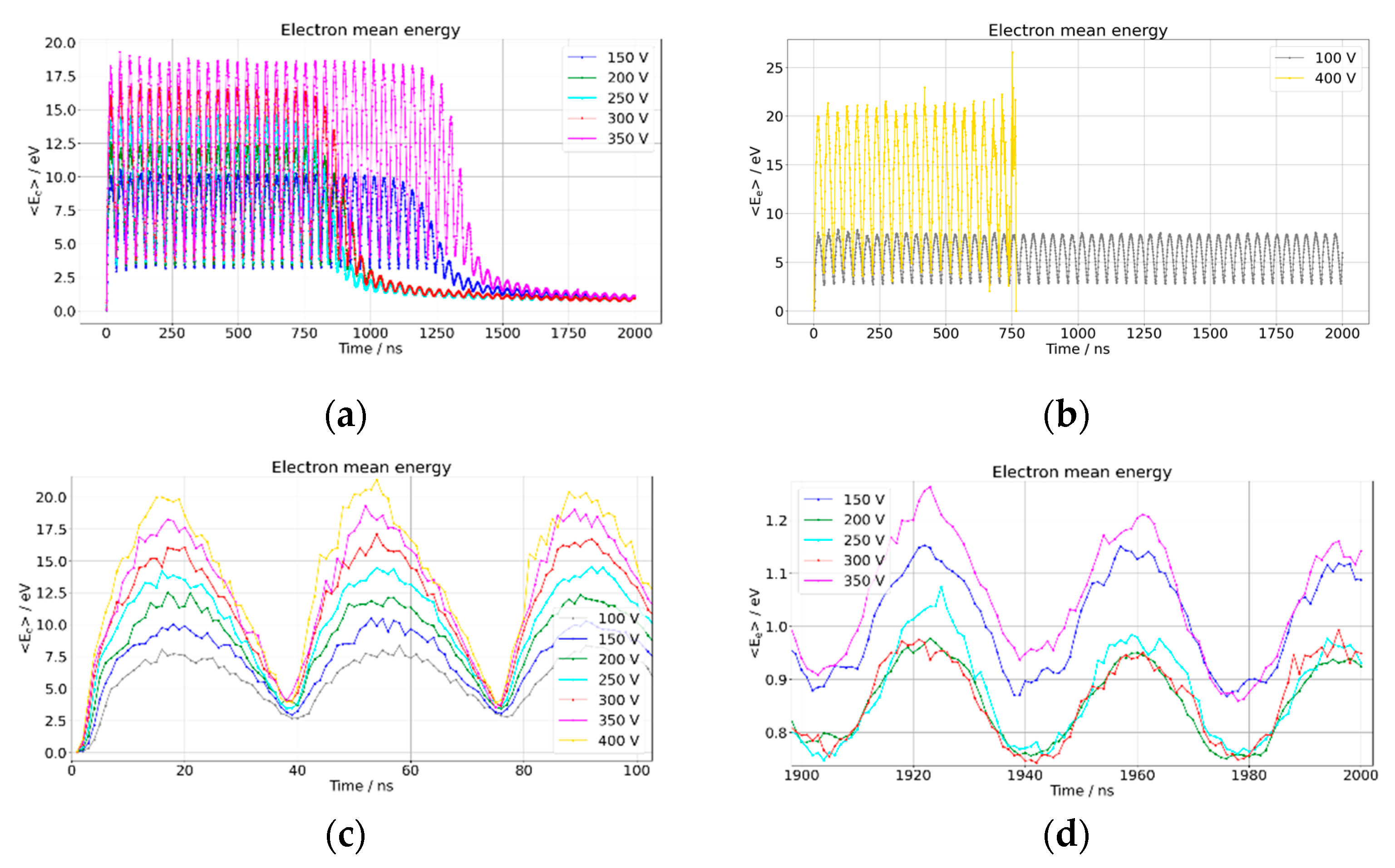

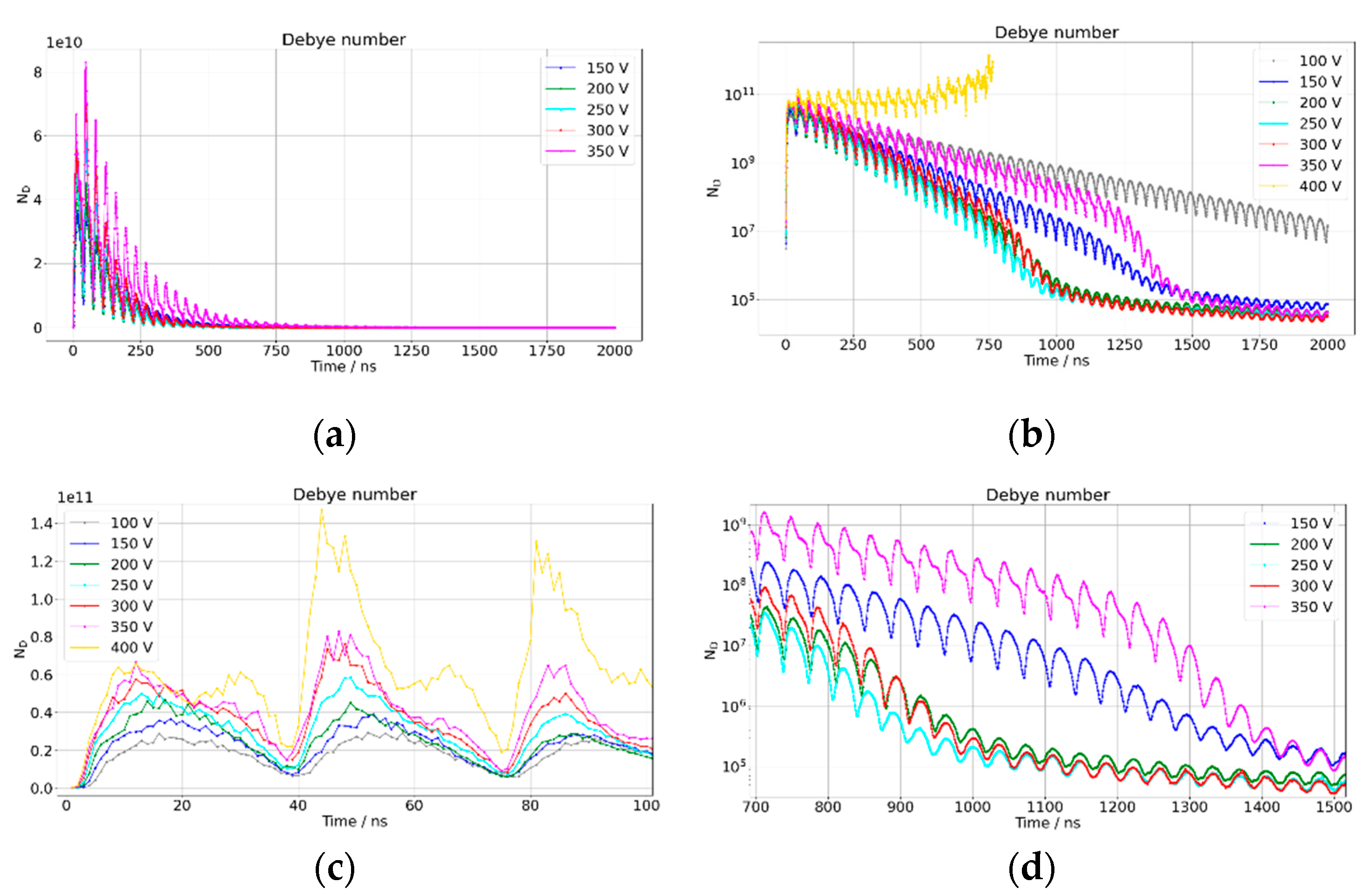
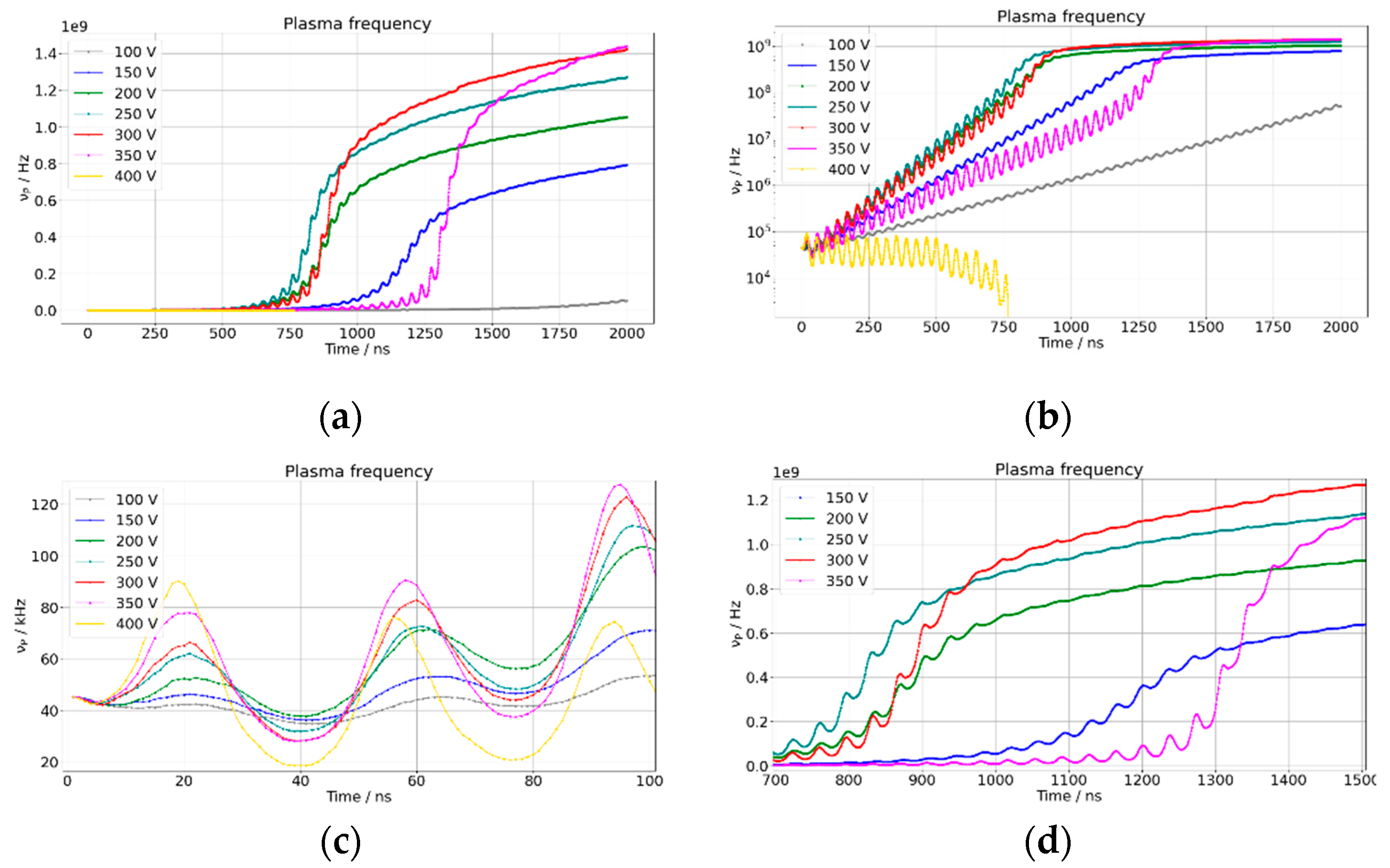


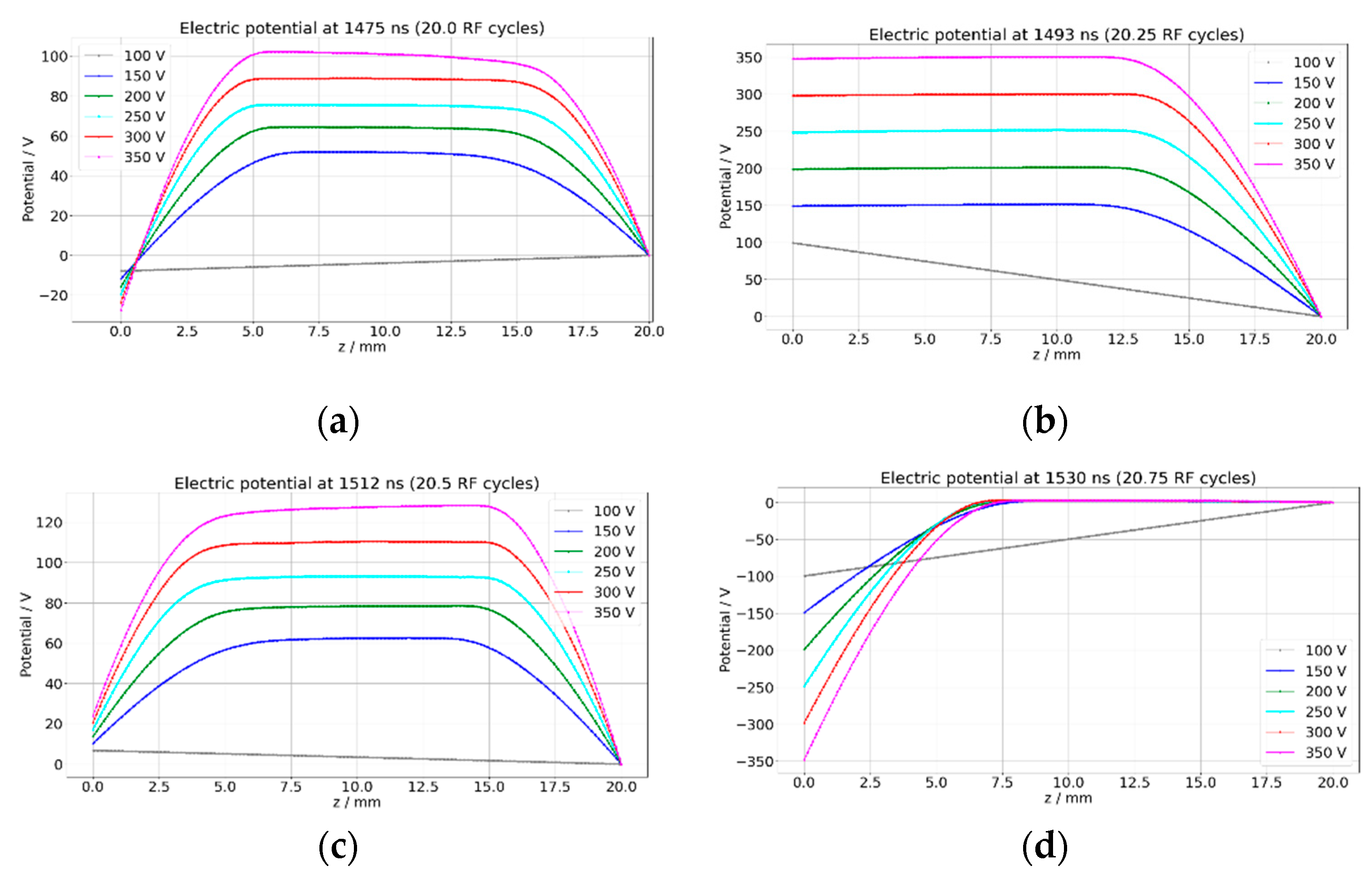




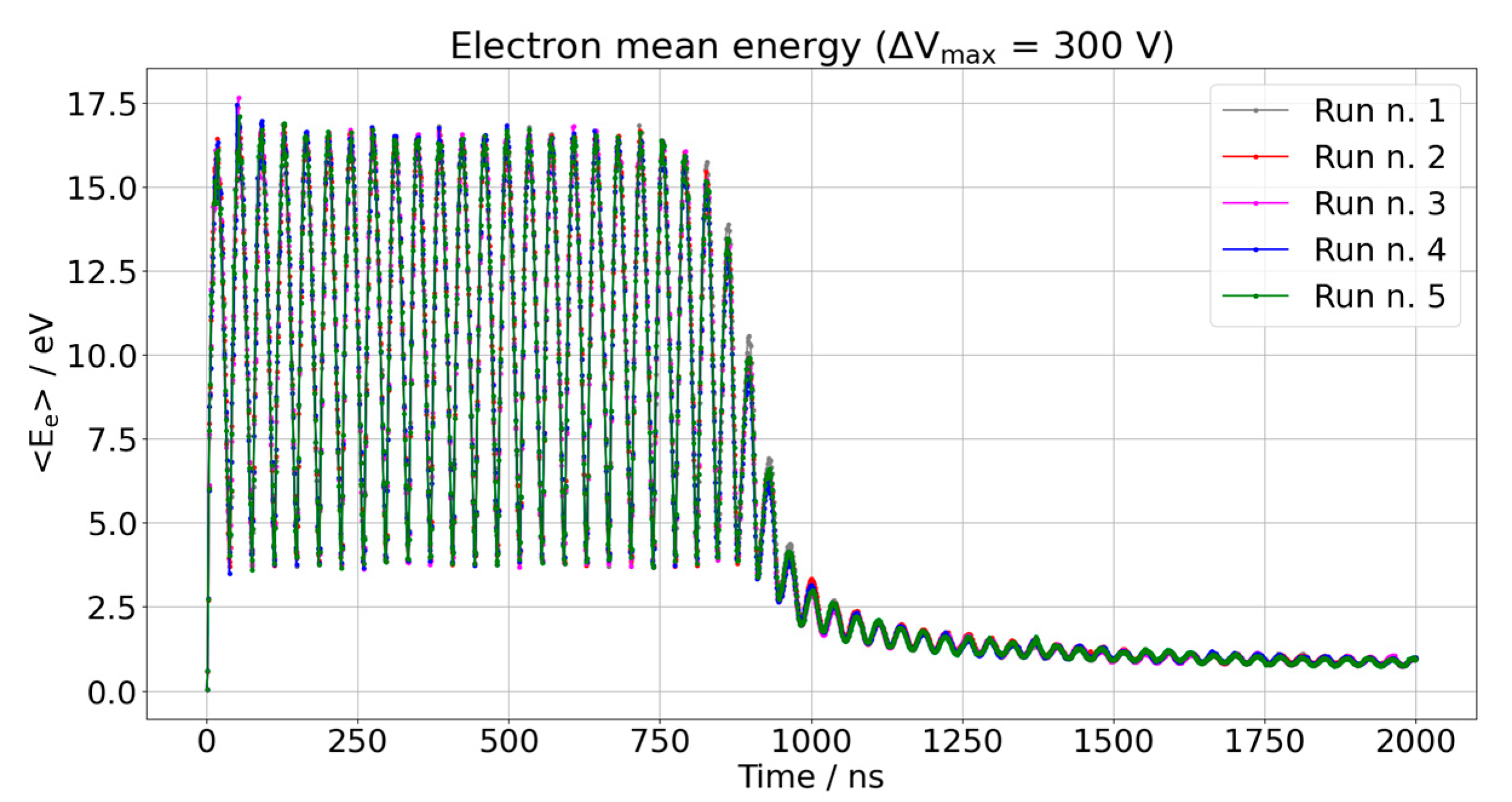
| Quantity | Symbol | Value | Unit |
|---|---|---|---|
| Electrodes lateral length | l | 250 | mm |
| Distance between the electrodes | d | 20 | mm |
| Plasma volume | Vpla = l2 · d | 1.25 × 10−3 | m3 |
| Gas temperature | Tgas | 300 | K |
| Gas pressure | p | 66.6 | Pa |
| Gas molecule density | ngas | 1.6 × 1022 | m−3 |
| Electric bias peak value | ∆Vmax | 100 | V |
| 150 | |||
| 200 | |||
| 250 | |||
| 300 | |||
| 350 | |||
| 400 | |||
| Electric bias frequency | νRF | 13.56 | MHz |
| Electric bias period | τRF = 1/νRF | 73.75 | ns |
| Electric bias starting phase | φ0 | 0 | ° |
| Quantity | Symbol | Value | Unit |
|---|---|---|---|
| Starting ionization degree | α(0) | 4 × 10−17 | |
| Starting electron density | ne(0) = ngas · α(0) | 6.41 × 105 | m−3 |
| Simulation time step | ∆t | 10 | ps |
| Time between data acquisitions | ∆toutput | 1 | ns |
| Overall simulated time | ∆ttotal | 2 | μs |
| Maximum number of computational particles | Nemax | 5 × 104 | |
| Number of PIC cells (1D) | Nz | 300 | |
| Dimension of a PIC cell | ∆z | 66.67 | μm |
Publisher’s Note: MDPI stays neutral with regard to jurisdictional claims in published maps and institutional affiliations. |
© 2022 by the author. Licensee MDPI, Basel, Switzerland. This article is an open access article distributed under the terms and conditions of the Creative Commons Attribution (CC BY) license (https://creativecommons.org/licenses/by/4.0/).
Share and Cite
Mandracci, P. Simulation of the First Two Microseconds of an Ar CCP Cold Plasma Discharge by the PIC-MCC Method. Plasma 2022, 5, 366-383. https://doi.org/10.3390/plasma5030028
Mandracci P. Simulation of the First Two Microseconds of an Ar CCP Cold Plasma Discharge by the PIC-MCC Method. Plasma. 2022; 5(3):366-383. https://doi.org/10.3390/plasma5030028
Chicago/Turabian StyleMandracci, Pietro. 2022. "Simulation of the First Two Microseconds of an Ar CCP Cold Plasma Discharge by the PIC-MCC Method" Plasma 5, no. 3: 366-383. https://doi.org/10.3390/plasma5030028
APA StyleMandracci, P. (2022). Simulation of the First Two Microseconds of an Ar CCP Cold Plasma Discharge by the PIC-MCC Method. Plasma, 5(3), 366-383. https://doi.org/10.3390/plasma5030028






